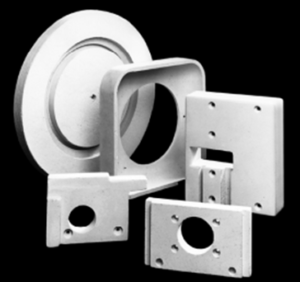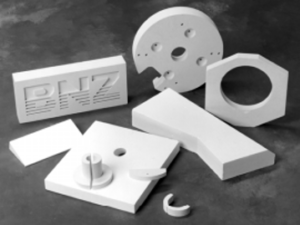Marinite Refractory Products – Fire-Resistant Thermal, Structural Insulation

Armil CFS offers a variety of Marinite® calcium silicate and Transite® fiber cement structural insulation boards.
Marinite boards combine high strength and excellent thermal insulating capabilities. Marinite® boards and fabricated shapes are used in a variety of heat processing, fire protection, and electrical resistance applications. Marinite I, Marinite P, Marinite A, and CS85 are available. Marinie FT has been recently developed for use in Live Fire Training Burn Rooms.
Transite® fiber cement industrial boards are used in high temperature applications where high strength and thermal shock resistance are the primary concerns. Parts fabricated from Transite® boards are also used as load bearing gaskets, spacers, supports, and other OEM applications.
Transite HT and Transite 1000 boards and shapes are available. (See the following data sheets for more information)
- Marinite Specifications (PDF)
- Transite Specifications (PDF)
- Marinite FT for fire training (PDF)
Additional information – Marinite I Insulation
Marinite I structural insulation is a non-asbestos incombustible material manufactured in 4′ x 8′ panel form. These boards are designed to combine compressive strength and high thermal insulating values in a variety of fireproofing and heat processing equipment applications. Formed from calcium silicate with inert fillers and reinforcing agents, Marinite I panels provide structure and insulation in a single, easily erected material.
In addition to high strength and excellent thermal insulating characteristics, Marinite I structural insulation is highly damage-resistant, noncorroding, and extremely water- resistant. Marinite panels also provide fire safety, uniform temperature control, minimal maintenance, and fast, easy fabrication.

Advantages
Uniform Temperature Control. Marinite I structural insulation is a solid, self-supporting material suitable for broken joint construction. It will not settle or sag to cause voids within the housing. The lack of through-metal support reduces heat loss and prevents localized hot spots. These characteristics provide uniform temperature control throughout the equipment, allowing better process control.
Eliminates Refractories. Because Marinite I panels provide excel- lent heat capacity and resistance to heat flow, resulting in a concentrated and steady heat impact on the charge, potentially expensive refractory linings can often be eliminated.
Easily Erected. Only a light steel frame is required to support the large panels.
Fire Safety. Marinite I panels have flame spread and smoke developed ratings of 0, 0, and are not damaged by flammable charges that are subject to occasional flaming.
Minimal Maintenance. Marinite I structural insulation is not affected by moisture or high humidity, and will not rust or corrode. In addition, the panels will not disintegrate even after pro- longed immersion in water. While panels can be painted if desired, preservative treatments are not required for interior applications.
Finishes
Marinite I panels can be painted either in the as-received condition or after suitable surface preparation, if aesthetics are extremely critical. Dents, scratches and sander marks should be pre-moistened and filled with a drywall patching compound. For a surface entirely free of sander marks and other blemishes, it is advisable to treat the entire surface with a wall glaze.
 The same finishing systems used for interior plaster walls are suitable. When painting the out- side of a dryer housing, however, a flat, breathing-type paint should be used to avoid trapped moisture and subsequent blistering and peeling. The following paints are recommended for interior use, in order of preference: water emulsion paints made with polyvinyl acetate, acrylic or latex emulsions; synthetic resin paints such as the alkyd type; rubber-base solvent- type masonry paints made with chlorinated rubber or and all types of insulating parts. In addition, Marinite I can be used in fire safety applications such as fire stops, fire walls, cable trays and fire doors, and provides an ideal, incombustible base for melamine veneers.
The same finishing systems used for interior plaster walls are suitable. When painting the out- side of a dryer housing, however, a flat, breathing-type paint should be used to avoid trapped moisture and subsequent blistering and peeling. The following paints are recommended for interior use, in order of preference: water emulsion paints made with polyvinyl acetate, acrylic or latex emulsions; synthetic resin paints such as the alkyd type; rubber-base solvent- type masonry paints made with chlorinated rubber or and all types of insulating parts. In addition, Marinite I can be used in fire safety applications such as fire stops, fire walls, cable trays and fire doors, and provides an ideal, incombustible base for melamine veneers.
The maximum service temperature of Marinite I is dependent upon the application, and application parameters vary greatly in size, thickness, temperature, heat flow equilibrium and construction — carefully review the enclosed data and also consult your sales representative/distributor for application recommendations.
Marinite I panels should be painted when excessive, external moisture is prevalent, especially accompanied by freeze-thaw conditions. Care should be exercised to keep the panels dry before painting. Proceed by sealing with one coat of Sherwin-Williams Masonry Conditioner A5V2, Glidden 5206, or equivalent. Then one coat of either a chlorinated rubber such as Sherwin-Williams Chlorinated Rubber B63 or Glidden 5501 Chlorinated Rubber, or top quality acrylic latex is applied.
Attachment Considerations
Marinite I is often mechanically attached using screws or nuts and bolts to materials having different thermal expansion characteristics, such as steel or concrete. Under these conditions it is imperative that drilled holes in the Marinite be at least 1⁄4″ oversize and screws or bolts be used with oversize washers. Do not overtighten the fasteners or even begin to pin the Marinite to the steel or concrete, as this will create thermal stresses upon heating which will cause cracking.
Electrical Properties
Marinite I panels possess relatively good electrical insulating properties when dry. Because the material is hygroscopic, however, moisture absorption lowers its electrical resistance. To minimize this effect, some users treat Marinite I with linseed oil or a similar moisture proofing.
As moisture pickup may be expected to cause problems under high-humidity ambient conditions or following the shutdown of equipment, Marinite I panels are not recommended for direct mounting of current-carrying parts. Despite this stipulation, treated Marinite I is used for this purpose, particularly at low voltage and at elevated temperatures. The decision to use the panels for electrical purposes must rest solely with the user, but it is suggested that protection be provided against electrical shock hazard.
Warpage Control
Most insulating materials, including Marinite I panels, shrink at temperatures above 300F. When heat is applied to only one side, the inner face of each layer will have a higher temperature and, consequently, will shrink more than the outer face. This causes the sheet to bow outward at the center. The greater the differential in temperature between the inner and outer face, the greater will be the warpage Also, the larger the panel size, the greater will be the warpage. To minimize warpage, use the table below to select the minimum number of 1″ thick layers for the operating temperature and corresponding largest panel dimension. This number is the minimum design thickness required based on those parameters, not heat flow or cold flow temperature.